Chunyang Chen
Faculty of Information Technology, Monash University, Australia
THEMIS: Towards Practical Intellectual Property Protection for Post-Deployment On-Device Deep Learning Models
Mar 31, 2025Abstract:On-device deep learning (DL) has rapidly gained adoption in mobile apps, offering the benefits of offline model inference and user privacy preservation over cloud-based approaches. However, it inevitably stores models on user devices, introducing new vulnerabilities, particularly model-stealing attacks and intellectual property infringement. While system-level protections like Trusted Execution Environments (TEEs) provide a robust solution, practical challenges remain in achieving scalable on-device DL model protection, including complexities in supporting third-party models and limited adoption in current mobile solutions. Advancements in TEE-enabled hardware, such as NVIDIA's GPU-based TEEs, may address these obstacles in the future. Currently, watermarking serves as a common defense against model theft but also faces challenges here as many mobile app developers lack corresponding machine learning expertise and the inherent read-only and inference-only nature of on-device DL models prevents third parties like app stores from implementing existing watermarking techniques in post-deployment models. To protect the intellectual property of on-device DL models, in this paper, we propose THEMIS, an automatic tool that lifts the read-only restriction of on-device DL models by reconstructing their writable counterparts and leverages the untrainable nature of on-device DL models to solve watermark parameters and protect the model owner's intellectual property. Extensive experimental results across various datasets and model structures show the superiority of THEMIS in terms of different metrics. Further, an empirical investigation of 403 real-world DL mobile apps from Google Play is performed with a success rate of 81.14%, showing the practicality of THEMIS.
A Semantic-based Optimization Approach for Repairing LLMs: Case Study on Code Generation
Mar 17, 2025Abstract:Language Models (LMs) are widely used in software engineering for code generation, but they may produce code with errors. Rather than repairing the generated code, an alternative way is to address the underlying failures of models. LM repair offers a lightweight solution to this challenge: it requires minimal data, reduces computational costs, and reduces the side effects. Unlike retraining, LM repair focuses on applying tailored updates to targeted neurons, making it ideal for scenarios with limited resources, high-performance demands, or strict safety requirements. In this paper, we propose \ul{S}emantic \ul{T}argeting for \ul{A}nalytical \ul{R}epair (\textsc{STAR}), a pioneering and novel semantic-based optimization approach for repairing LLMs. \textsc{STAR} realizes main operations in LM repair methods in an optimization process, including locating ``buggy neurons'', solving ``neuron patches'', and patching ``buggy neurons''. Correspondingly, it computes the deltas of weight matrix as the prior information to guide optimization; and attributes the targeted layers and neurons leveraging statistical insights. The neuron patches are computed with a solid semantic-based analytical formula, which directly bridges the changes to logits with the deltas of neurons, by steering latent representations. Compared to the prior work of LM repair (\textsc{MINT}) and optimization methods (\textsc{SGD}), \textsc{STAR} integrates their strengths while mitigating their limitations. \textsc{STAR} supports solving multiple failures together, significantly improving the usefulness. Evaluated on three code generation tasks using popular code LMs, \textsc{STAR} demonstrates superior effectiveness. Additionally, \textsc{STAR} exhibits better efficiency. In terms of side effects, namely the balance between generalization and specificity, \textsc{STAR} outperforms prior work by a significant margin.
A Semantic-based Layer Freezing Approach to Efficient Fine-Tuning of Language Models
Jun 17, 2024Abstract:Finetuning language models (LMs) is crucial for adapting the models to downstream data and tasks. However, full finetuning is usually costly. Existing work, such as parameter-efficient finetuning (PEFT), often focuses on \textit{how to finetune} but neglects the issue of \textit{where to finetune}. As a pioneering work on answering where to finetune (at the layer level), we conduct a semantic analysis of the LM inference process. We first propose a virtual transition of the latent representation and then trace its factual transition. Based on the deviation in transitions, we estimate the gain of finetuning each model layer, and further, narrow down the scope for finetuning. We perform extensive experiments across well-known LMs and datasets. The results show that our approach is effective and efficient, and outperforms the existing baselines. Our approach is orthogonal to existing efficient techniques, such as PEFT methods, offering practical values on LM finetuning.
Beyond Accuracy: An Empirical Study on Unit Testing in Open-source Deep Learning Projects
Feb 26, 2024Abstract:Deep Learning (DL) models have rapidly advanced, focusing on achieving high performance through testing model accuracy and robustness. However, it is unclear whether DL projects, as software systems, are tested thoroughly or functionally correct when there is a need to treat and test them like other software systems. Therefore, we empirically study the unit tests in open-source DL projects, analyzing 9,129 projects from GitHub. We find that: 1) unit tested DL projects have positive correlation with the open-source project metrics and have a higher acceptance rate of pull requests, 2) 68% of the sampled DL projects are not unit tested at all, 3) the layer and utilities (utils) of DL models have the most unit tests. Based on these findings and previous research outcomes, we built a mapping taxonomy between unit tests and faults in DL projects. We discuss the implications of our findings for developers and researchers and highlight the need for unit testing in open-source DL projects to ensure their reliability and stability. The study contributes to this community by raising awareness of the importance of unit testing in DL projects and encouraging further research in this area.
On the Semantics of LM Latent Space: A Vocabulary-defined Approach
Feb 02, 2024Abstract:Understanding the latent space of language models (LM) is crucial to refining their performance and interpretability. Existing analyses often fall short in providing disentangled (model-centric) insights into LM semantics, and neglect essential aspects of LM adaption. In response, we introduce a pioneering method called vocabulary-defined semantics, which establishes a reference frame within the LM latent space, ensuring disentangled semantic analysis grounded in LM vocabulary. Our approach transcends prior entangled analysis, leveraging LM vocabulary for model-centric insights. Furthermore, we propose a novel technique to compute logits, emphasising differentiability and local isotropy, and introduce a neural clustering module for semantically calibrating data representations during LM adaptation. Through extensive experiments across diverse text understanding datasets, our approach outperforms state-of-the-art methods of retrieval-augmented generation and parameter-efficient finetuning, showcasing its efficacy and broad applicability. Our findings not only shed light on LM mechanics, but also offer practical solutions to enhance LM performance and interpretability.
Neuron Patching: Neuron-level Model Editing on Code Generation and LLMs
Dec 08, 2023
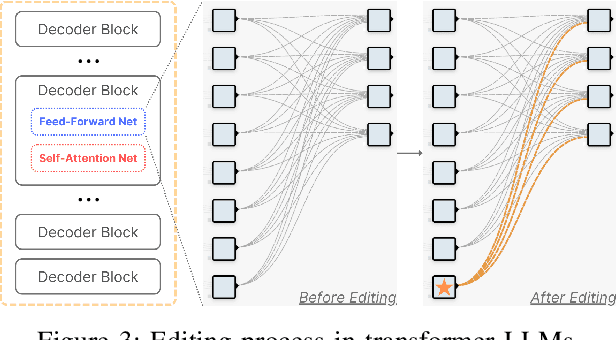
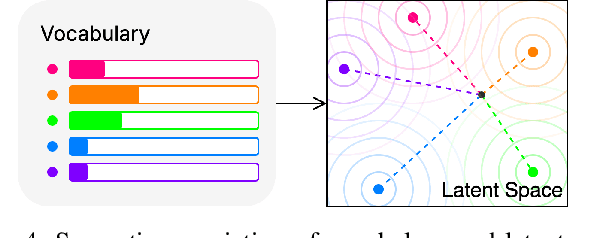
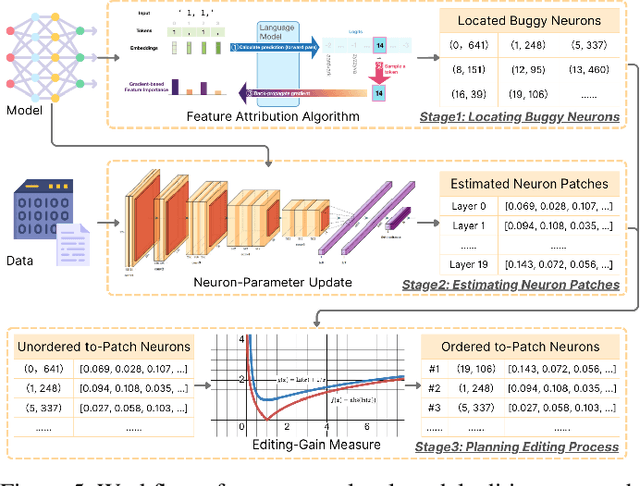
Abstract:Large Language Models are successfully adopted in software engineering, especially in code generation. Updating these models with new knowledge is very expensive, and is often required to fully realize their value. In this paper, we propose a novel and effective model editing approach, \textsc{MENT}, to patch LLMs in coding tasks. Based on the mechanism of generative LLMs, \textsc{MENT} enables model editing in next-token predictions, and further supports common coding tasks. \textsc{MENT} is effective, efficient, and reliable. It can correct a neural model by patching 1 or 2 neurons. As the pioneer work on neuron-level model editing of generative models, we formalize the editing process and introduce the involved concepts. Besides, we also introduce new measures to evaluate its generalization ability, and build a benchmark for further study. Our approach is evaluated on three coding tasks, including API-seq recommendation, line-level code generation, and pseudocode-to-code transaction. It outperforms the state-of-the-art by a significant margin on both effectiveness and efficiency measures. In addition, we demonstrate the usages of \textsc{MENT} for LLM reasoning in software engineering. By editing the LLM knowledge with \textsc{MENT}, the directly or indirectly dependent behaviors in the chain-of-thought change accordingly and automatically.
GNNEvaluator: Evaluating GNN Performance On Unseen Graphs Without Labels
Oct 26, 2023



Abstract:Evaluating the performance of graph neural networks (GNNs) is an essential task for practical GNN model deployment and serving, as deployed GNNs face significant performance uncertainty when inferring on unseen and unlabeled test graphs, due to mismatched training-test graph distributions. In this paper, we study a new problem, GNN model evaluation, that aims to assess the performance of a specific GNN model trained on labeled and observed graphs, by precisely estimating its performance (e.g., node classification accuracy) on unseen graphs without labels. Concretely, we propose a two-stage GNN model evaluation framework, including (1) DiscGraph set construction and (2) GNNEvaluator training and inference. The DiscGraph set captures wide-range and diverse graph data distribution discrepancies through a discrepancy measurement function, which exploits the outputs of GNNs related to latent node embeddings and node class predictions. Under the effective training supervision from the DiscGraph set, GNNEvaluator learns to precisely estimate node classification accuracy of the to-be-evaluated GNN model and makes an accurate inference for evaluating GNN model performance. Extensive experiments on real-world unseen and unlabeled test graphs demonstrate the effectiveness of our proposed method for GNN model evaluation.
Towards Real Smart Apps: Investigating Human-AI Interactions in Smartphone On-Device AI Apps
Jul 03, 2023Abstract:With the emergence of deep learning techniques, smartphone apps are now embedded on-device AI features for enabling advanced tasks like speech translation, to attract users and increase market competitiveness. A good interaction design is important to make an AI feature usable and understandable. However, AI features have their unique challenges like sensitiveness to the input, dynamic behaviours and output uncertainty. Existing guidelines and tools either do not cover AI features or consider mobile apps which are confirmed by our informal interview with professional designers. To address these issues, we conducted the first empirical study to explore user-AI-interaction in mobile apps. We aim to understand the status of on-device AI usage by investigating 176 AI apps from 62,822 apps. We identified 255 AI features and summarised 759 implementations into three primary interaction pattern types. We further implemented our findings into a multi-faceted search-enabled gallery. The results of the user study demonstrate the usefulness of our findings.
Enhancing Virtual Assistant Intelligence: Precise Area Targeting for Instance-level User Intents beyond Metadata
Jun 07, 2023Abstract:Virtual assistants have been widely used by mobile phone users in recent years. Although their capabilities of processing user intents have been developed rapidly, virtual assistants in most platforms are only capable of handling pre-defined high-level tasks supported by extra manual efforts of developers. However, instance-level user intents containing more detailed objectives with complex practical situations, are yet rarely studied so far. In this paper, we explore virtual assistants capable of processing instance-level user intents based on pixels of application screens, without the requirements of extra extensions on the application side. We propose a novel cross-modal deep learning pipeline, which understands the input vocal or textual instance-level user intents, predicts the targeting operational area, and detects the absolute button area on screens without any metadata of applications. We conducted a user study with 10 participants to collect a testing dataset with instance-level user intents. The testing dataset is then utilized to evaluate the performance of our model, which demonstrates that our model is promising with the achievement of 64.43% accuracy on our testing dataset.
Structure-free Graph Condensation: From Large-scale Graphs to Condensed Graph-free Data
Jun 05, 2023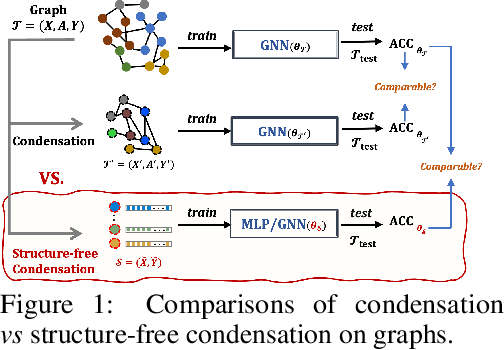
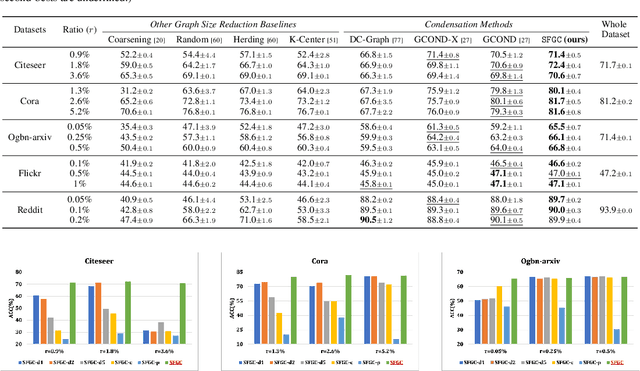
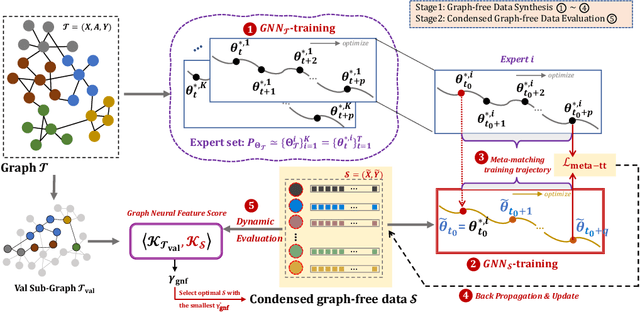
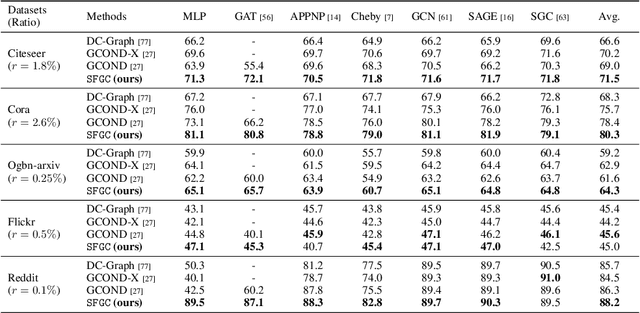
Abstract:Graph condensation, which reduces the size of a large-scale graph by synthesizing a small-scale condensed graph as its substitution, has immediate benefits for various graph learning tasks. However, existing graph condensation methods rely on the joint optimization of nodes and structures in the condensed graph, and overlook critical issues in effectiveness and generalization ability. In this paper, we advocate a new Structure-Free Graph Condensation paradigm, named SFGC, to distill a large-scale graph into a small-scale graph node set without explicit graph structures, i.e., graph-free data. Our idea is to implicitly encode topology structure information into the node attributes in the synthesized graph-free data, whose topology is reduced to an identity matrix. Specifically, SFGC contains two collaborative components: (1) a training trajectory meta-matching scheme for effectively synthesizing small-scale graph-free data; (2) a graph neural feature score metric for dynamically evaluating the quality of the condensed data. Through training trajectory meta-matching, SFGC aligns the long-term GNN learning behaviors between the large-scale graph and the condensed small-scale graph-free data, ensuring comprehensive and compact transfer of informative knowledge to the graph-free data. Afterward, the underlying condensed graph-free data would be dynamically evaluated with the graph neural feature score, which is a closed-form metric for ensuring the excellent expressiveness of the condensed graph-free data. Extensive experiments verify the superiority of SFGC across different condensation ratios.
 Add to Chrome
Add to Chrome Add to Firefox
Add to Firefox Add to Edge
Add to Edge